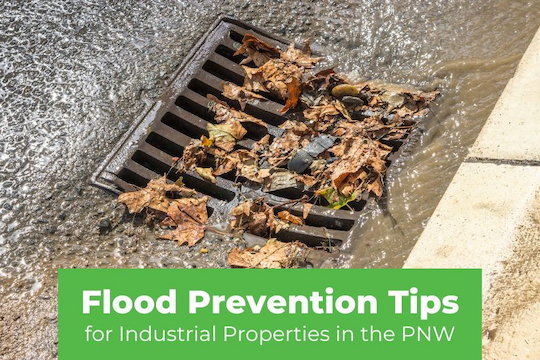Maintaining commercial storm drains effectively can prevent clogged drains and money spent on expensive damage, repairs, or cleanups. Well-maintained storm drains also extend the life of the more extensive stormwater management system, keeping the number of pollutants entering stormwater drainage systems to a minimum. With a few commercial storm drain cleaning tips, clogged storm drains will become a thing of the past.
Why Is It Important to Clean Storm Drains?

Commercial storm drains play an essential part in moving all the stormwater and runoff away from outdoor areas and carrying it to local streams, rivers, wetlands, and the ocean.
When water pools after a storm, bacteria can thrive, and mosquitos start to breed. If the stormwater can’t flow into a storm drain, the excess flow may cause basement flooding, damaged landscaping, and problems with surrounding properties.
Tip: Understand How the Catch Basin Works
Stormwater systems usually include catch basins as a first step. A catch basin is a box with an inlet and outlet added to the underground drain connection and a sump at the bottom. As the stormwater runs off the ground into the storm drain, it often brings with it leaves, sediment, trash, and other debris.
With a catch basin, the debris and trash fall to the bottom of the square basin. As more water fills up the basin, the debris stays at the bottom, in the sump. The stormwater flows out through a higher drain opening and continues down through the connected drainage pipe away from the property.
Catch basins prevent the clogs that can keep a storm drain from doing its job. The captured debris and sediment fill up over time and catch basins need to have periodic cleanings. Municipal inspectors check annually for sediment levels in sumps to determine whether a structure is in compliance.
Clogged storm drains can cause flooding problems and water damage to buildings, vehicles, landscaped areas, and more. It’s essential to have an inspection performed for problem drains. Otherwise, you might spend time and money fixing a seemingly minor problem while not addressing the root cause.
Tip: How to Unclog and Clean Storm Drains

Your vendor will apply a number of techniques to try to unclog your stormwater pipe. They may need a hydro-jet to apply enough pressure to push debris, tree roots, sediment, and other objects further down and out of the drain or line.
Here’s one of the best commercial storm drain cleaning tips. When you need efficient storm drain cleaning, especially with full catch basins, your vendor will most likely use an industrial vacuum to remove debris, such as a Vactor truck. The debris removed by the Vactor truck also needs to be disposed of safely and properly.
In many cases, storm drain and catch basin cleaning involve scooping out large quantities of pollutant-filled sludge. Your vendor should be able to provide specialized services, have updated equipment like Vactor trucks, and experienced staff, to clean the storm drain properly. The sludge must be discarded in specific ways, such as bringing it to a hazardous waste facility through a licensed waste hauler.
Avoid using chemical-based solutions to unclog storm drains. The drainage water ultimately goes untreated into freshwater bodies, and the chemical pollution has significant adverse effects on water quality and aquatic life.
Tip: How Often You Should Clean Storm Drains

You should clean storm drains and catch basins frequently to avoid problems. To set the schedule, your vendor will observe the drain’s performance over time and note whether blockage and flooding happen regularly. Increase the cleaning frequency, if necessary, during more frequent rain or snow periods.
An increased cleaning frequency also helps if the storm drain is prone to collecting litter and debris and has a history of becoming obstructed or clogged. You can reduce the storm drain maintenance frequency by regularly maintaining the areas around the drain. This action includes sweeping up fallen leaves and other debris.
Clean up any trash that collects around the drains, and trim surrounding trees to keep branches from falling into the storm drain. It only takes one branch falling into a storm drain to catch other debris from the water flow and start a clog.
Tip: When You Need to Call an Expert
Sometimes cleaning a storm drain means simply lifting the grate and pulling out a few pieces of trash. Other times, issues come up such as:
- You have cleaned out a clogged drain, but the flooding problem doesn’t resolve
- The job requires more heavy-duty tools or machinery, such as a Vactor truck or hydro-jet, and the trained staff to use them
- The storm drainage system contains a clog, but you aren’t sure exactly it is or how to approach unclogging it
- The problem seems larger than initially thought
Catch-All Environmental can help with all these scenarios and more. We have the equipment, engineers, staff, and expertise to resolve your storm drain problems efficiently and cost-effectively.
Contact us today with your storm drain challenges and see how we can help.













